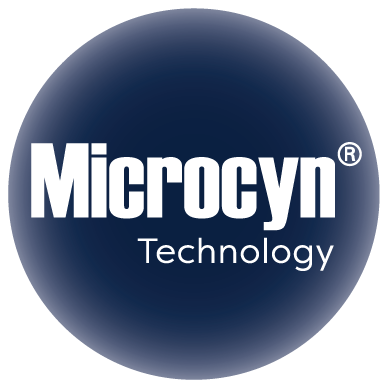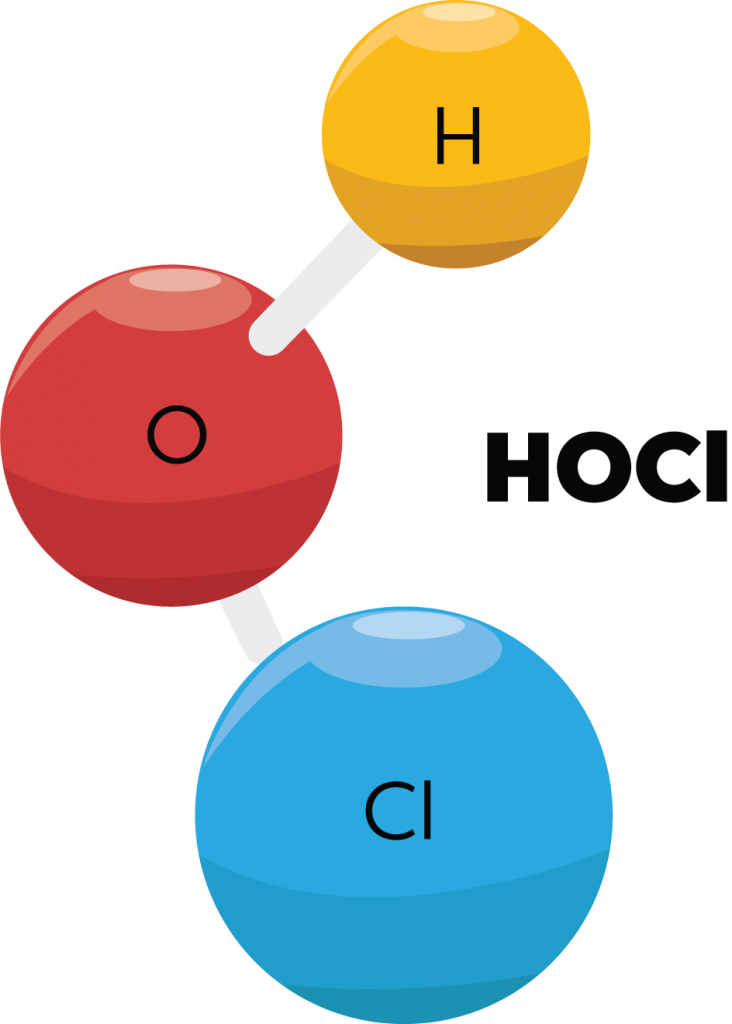Microcyn® Technology
Natural body ingredients that boost your immune system
Tightly controlled chemistry resulting in unmatched stability. Our Microcyn® technology is based on one of the body’s most important molecules: Hypochlorous acid (HOCl).
Launched in 2004, it was the first revolutionary stable patented HOCl formulation in a bottle. With virtually no side effects or contraindications, you can utilize our solutions as often as needed to cleanse skin, relieve irritations and restore your well-being and peace of mind.

Microcyn® Technology – Safe as water
In-vitro and clinical studies of Hypochlorous Acid (HOCl) show it to have impressive antipruritic, antimicrobial and anti-inflammatory properties. The Microcyn® Technology not only optimizes HOCl for superior efficacy and safety, it guarantees potency for the life of the product. With virtually no side effects or contraindications, you can utilize Microcyn®-based products as often as needed to cleanse skin, relieve irritations and restore your well-being and peace of mind.
- Cleanse
- Relieve
- Restore
Microcyn® Technology
The Microcyn®-based family of products are formulated from an electrically charged oxychlorine compound of small molecules. This Microcyn® Technology hypochlorous acid is similar to the natural hypochlorous compound produced by the human body’s immune system upon demand to eradicate foreign pathogens in the body.
The unique chemistry imparted through the patented Microcyn® manufacturing system provides superior product stability. Standard electrochemical processes used in the manufacture of other hypochlorous acid-containing products, cannot come close to matching this stability.
There are no known drug interactions or contraindications with Microcyn®-based products. Testing has demonstrated the gel and liquid products to be non-irritating, non-sensitizing and non-toxic. Microcyn®-based liquid products have been found to have no oral toxicity, cause no ocular irritation and are non-genotoxic.

Hypochlorous Acid
The science of hypochlorous acid is simultaneously deceptively simple and highly complex. When developed intelligently and with scientific rigor, hypochlorous acid can be rendered safe, stable and consistent in an advanced wound care formulation. This is the foundation for our patented Microcyn® technology.
Under development and continuous refinement for almost 20 years, Microcyn® Technology is the original and very first hypochlorous acid introduced into the U.S. advanced wound care market.
Microcyn® Technology is highly stable, up to two years or more, and proven safe (non-cytotoxic).
TRIPLE MODE OF ACTION
3x
Based on one of the body’s most important molecules, Hypochlorous acid (HOCl), Microcyn® Technology has a Triple Mode of Action and profound impact on infection, inflammation and scarring:
Anti-microbial
In-vitro and clinical studies of Microcyn Technology breaks down the biofilm along with having impressive anti-pruritic, anti-microbial, anti-viral and anti-inflammatory properties.
Anti-inflammatory
A powerful anti-inflammatory, our products treat common conditions while reducing infections, itch, pain, scarring and harmful inflammatory responses.
Regenerative
A gentle and safe solution that increases blood/oxygen flow to the wound, resulting in faster, more effective healing.
Microcyn® Technology Applications
Cleanse
Safely eradicates biofilm and other irritants.
Greater than 99% reduction in killing 23 different microorganisms

-
Complex structure of microorganisms that generate a protective shell, allowing bacteria to collect and proliferate

Relieve
Reduces inflammation, pain, itch and swelling fast.
Study 1: Open-Label Study2
Open-label, single-arm study over 7 days
Results
HOCl rapidly reduces pruritus in mild-to-moderate atopic dermatitis (AD)

Study 2: Randomized, Blinded, Controlled Study3
- 72-hour study
- Treated group (n=19): HOCl BID
- Untreated group (n=10): No treatment
Results
The mean pruritus VAS scores saw a greater improvement among the treated group than the untreated group between baseline and 72 hours post application

- Prevents allergen and calcium-induced mast cell degranulation for up to 8 hours after a single exposure in vitro
- Reduces wound inflammation that inhibits healing
- Stabilizes the mast cell membrane to inhibit the cell machinery for granule secretion, while not altering the signal transduction pathways or calcium mobilization
- Inhibits degranulation stimulated by antigen or calcium ionophore

*A23187 + PMA is a calcium ionophore; †b-hexosaminidase is a marker of IgE-antigen-induced mast cell degranulation.
Restore
Increasing oxygen to the area in need helps accelerate the body’s natural healing process.
Increases Oxygenation5

Assists Wound Healing6
Wound healing involves a complex sequence of events. Fibroblasts are the primary synthetic cells in the repair process of most structural proteins used during tissue reconstruction.
At lower concentrations of HOCl, the percentage of fibroblast migration exceeded that of the control at 24 hours.

Effect of HOCl on Skin Fibroblast Cell Migration in a Wound Healing Assay
Microcyn® Technology is suitable for the following indications
Unique chemistry
The main component, hypochlorous acid (HOCl), is naturally produced as part of our immune system during phagocytosis. When neutrophils encounter bacteria or other pathogens, the neutrophils engulf it, generate HOCl and instantly destroys the microorganism. This process is called the “oxidative burst”.
During the activation of neutrophils, ‘respiratory bursts’ generate hydrogen peroxide (H2O2) and the activated granule enzyme myeloperoxidase converts H2O2 into hypochlorous acid (HOCl).
Safety
Impact of Microcyn® Technology on Fibroblast Cells as Compared to Brand V in Negative-Pressure Instillation Simulation
Study
An in-vitro study was conducted in which confluent monolayers of L-929 mouse fibroblast cells (as recommended by ISO and USP guidelines) were prepared and challenged by both Microcyn® Negative-Pressure Wound Therapy Solution and Brand V solution. The study was conducted on these fibroblast cells to evaluate potential toxicity with repeated exposure in-vitro. Results were recorded at one-hour intervals after four 15-second exposures (instillation), and later at 24 hours.
Microcyn Solution samples were graded as non-toxic: Grade 1 to L-929 mouse fibroblast cells under the conditions of this study. The Brand V samples were graded as cytotoxic: Grade 3 to L-929 mouse fibroblast cells under the conditions of this study. After 24 hours, the results remained unchanged.
Results
The monolayers of fibroblast cells were graded using light microscopy. Cellular morphology was graded in accordance with the ISO acceptance criteria and USP guidelines.
Microcyn® Exposure: As shown in microscopic photos numbered one and two, the fibroblast cells exposed to the Microcyn® Technology maintained their viability and indicate a non-toxic level of exposure.
Microcyn Exposure
As shown in microscopic photos numbered one and two, the fibroblast cells exposed to the Microcyn® Technology maintained their viability and indicate a non-toxic level of exposure.
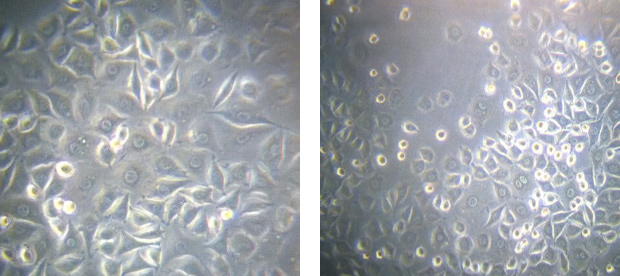
| 1 Representative Image of Microcyn Treatment at T=1. After First 15 sec Exposure to 1ml (5ml Microcyn:1ml MEM) of L-929 Cells. Photo taken an hour after exposure at 200X |
2 Representative Image of Microcyn Treatment at T=4. After Fourth 15 sec Exposure to 1ml (5ml Microcyn:1ml MEM) of L-929 Cells. Photo taken an hour after exposure at 200X. |
Brand V Exposure
As shown in microscopic photos numbered 3 and 4, the fibroblast cells exposed to the Brand V solution after the fourth treatment did not maintain their viability and indicate a cytotoxic level of exposure. Notice the proliferation of round, non-viable cells in photo four.
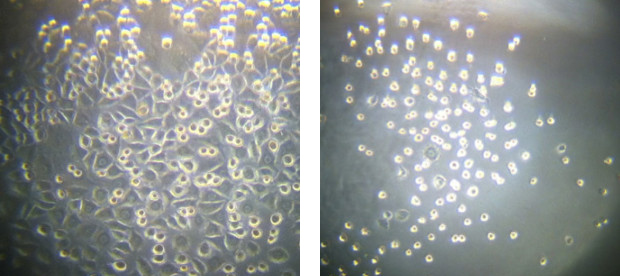
| 3 Representative Image of Brand V Treatment at T=1. After First 15 sec Exposure to 1ml (5ml Brand V:1ml MEM) of L-929 Cells. Photo taken an hour after exposure at 200X. |
4 Representative Image of Brand V Treatment at T=4. After Fourth 15 sec Exposure to 1ml (5ml Brand V:1ml MEM) of L-929 Cells. Photo taken an hour after exposure at 200X. |
Shelf Stability
The patented and proprietary manufacturing process of the original Microcyn® Technology guarantees that each and every lot of Microcyn® hypochlorous acid is consistently safe and stable, always within our strict manufacturing specifications. Not all HOCl solutions can make this claim. In fact, some HOCl irrigants can actually inhibit wound healing and harm mammalian cells due to their cytotoxicity and inability to maintain control over free available chlorine (FAC) levels.
Due to poor stability, competitive hypochlorous acid products are generated at very high concentrations of HOCl to assure product preservation over their shelf lives. The concentration of HOCl in these products, therefore, varies significantly depending on product age. The initial elevated level of HOCl in Brand V is necessary to assure that some free available chlorine is available at the end of that product’s shelf life. It is also indicative of a product that likely has cytotoxic tendencies towards human cells. Both Microcyn and Brand V HOCl formulations were scientifically tested to determine levels of FAC at time of manufacture and over the shelf life of the products.
This chart demonstrates the level of degradation of the Brand V 500 mL product over a 240-day period as compared to the Microcyn® 500 mL product. As is shown in the chart, Brand V degrades at seven times the rate of Microcyn®. As a result, Brand V is required to manufacture an HOCL product at a relatively high and cyto-toxic “free available chlorine” level of 300 parts per milions in order to secure a minimum level of shelf life.
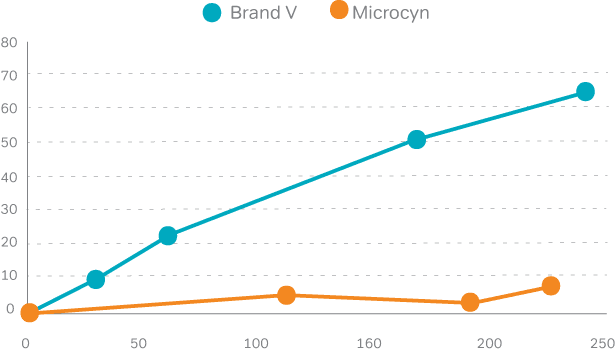
Preservative Testing
Microcyn® Skin and Wound Care with Preservatives demonstrates in vitro activity against a broad spectrum of gram-negative, gram-positive and yeast species in just 30 seconds.
Preservative Testing – Successfully meets USP Category 1 Criteria.
| Organisms | Result Day 7 | Result Day 14 | Result Day 28 |
|---|---|---|---|
| P. aeruginosa ATCC 9027 | >1 log reductionfrom the initial
calculated count |
> 3.0 log reductionfrom the initial
calculated count |
No increase from Day 14 |
| E. coli ATCC 8739 | |||
| S. aureus ATCC 6538 | |||
| C. albicans ATCC 10231 | No increase from theinitial calculated count | No increase from theinitial calculated count | No increase from theinitial calculated count |
| A. niger ATCC 16404 |
Preservative Time Kill Testing
| Name of Organism | Log Reduction (30 sec.) | Time to Kill | Percent Reduction |
|---|---|---|---|
| Acinetobacter baumannii | 6.3692 | 30 seconds | 99.9999% |
| Bacteroides fragilis | 7.6435 | 30 seconds | 99.9999% |
| Candida albicans | 6.3345 | 30 seconds | 99.9999% |
| Enterobacter aerogenes | 6.0881 | 30 seconds | 99.9999% |
| Enterococcus faecalis-VRE | 6.3646 | 30 seconds | 99.9999% |
| Enterococcus faecium-VRE MDR | 6.5119 | 30 seconds | 99.9999% |
| Escherichia coli | 5.6990 | 30 seconds | 99.9998% |
| Haemophilus influenzae | 5.1775 | 30 seconds | 99.9993% |
| Klebsiella oxytoca-MDR | 6.0492 | 30 seconds | 99.9999% |
| Klebsiella pneumoniae | 6.1430 | 30 seconds | 99.9999% |
| Micrococcus luteus | 5.8420 | 30 seconds | 99.9999% |
| Proteus mirabilis | 6.2028 | 30 seconds | 99.9999% |
| Pseudomonas aeruginosa | 5.8096 | 30 seconds | 99.9998% |
| Serratia marcescens | 5.9978 | 30 seconds | 99.9999% |
| Staphylococcus aureus-MRSA | 6.3454 | 30 seconds | 99.9999% |
| Staphylococcus aureus | 6.2266 | 30 seconds | 99.9999% |
| Staphylococcus epidermidis | 6.0233 | 30 seconds | 99.9999% |
| Staphylococcus haemolyticus | 5.9112 | 30 seconds | 99.9999% |
| Staphylococcus homins | 5.4456 | 30 seconds | 99.9996% |
| Staphylococcus saprophyticus | 5.9590 | 30 seconds | 99.9999% |
| Streptococcus pyogenes | 6.7160 | 30 seconds | 99.9999% |
Note: The solution contains sodium hypochlorite and hypochlorous acid as preservatives to reduce/ prevent the growth of microorganisms within the solution. The effect of this product in the wound bed has not been tested clinically.

